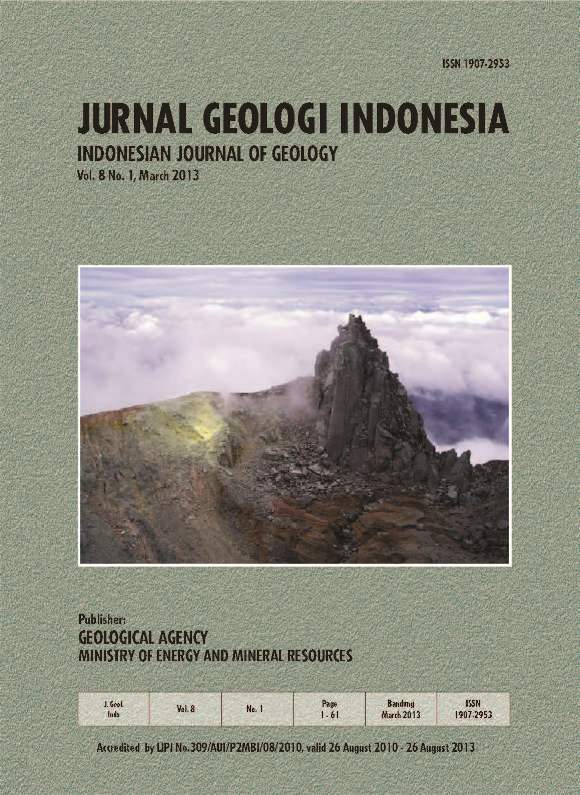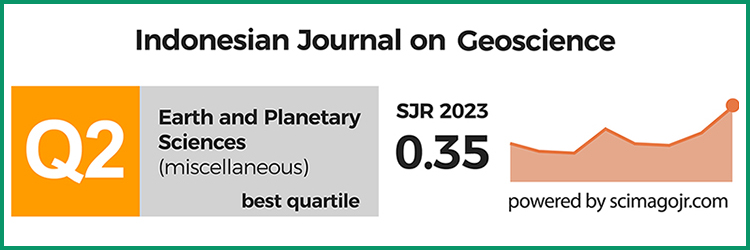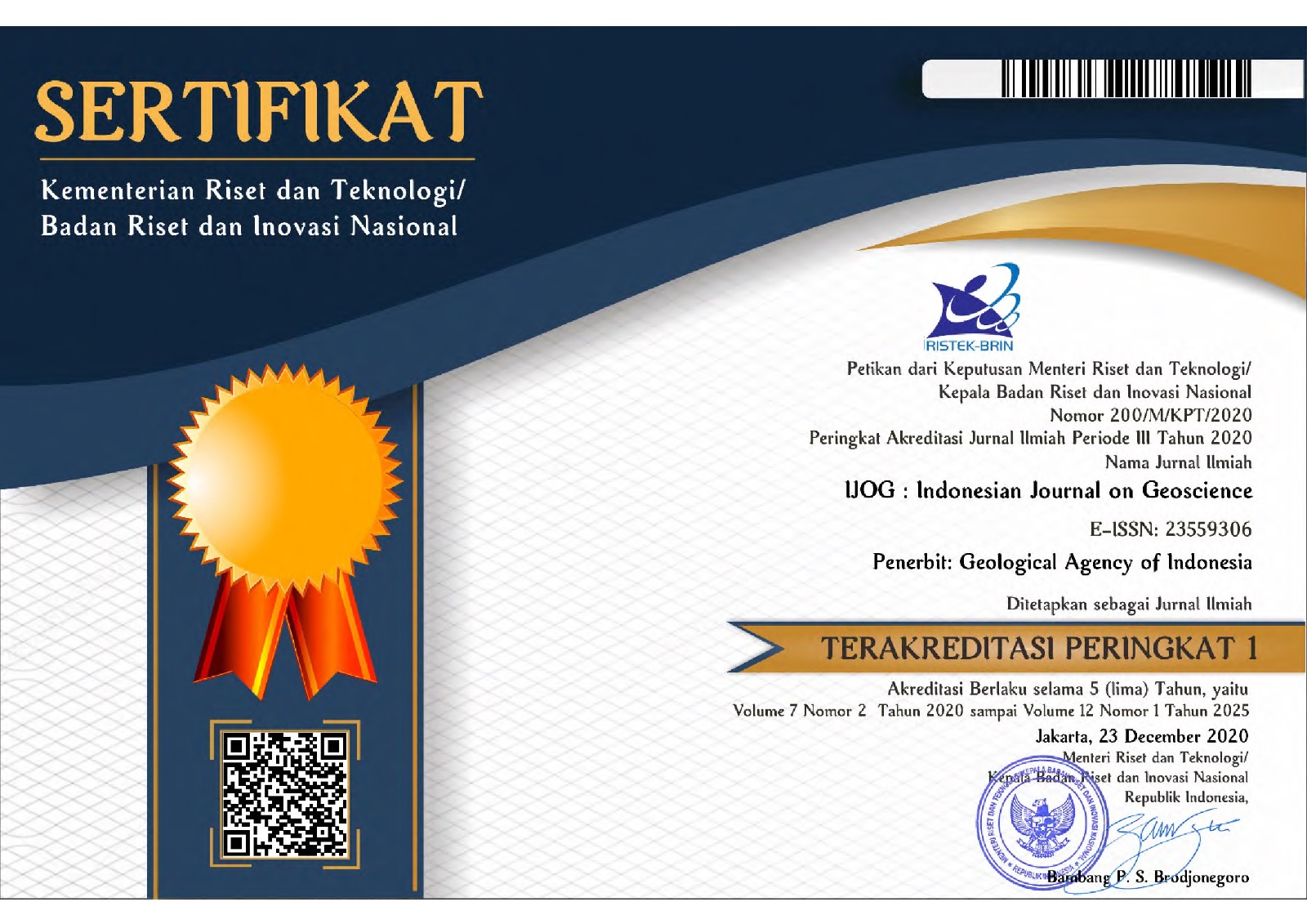Shell Bed Identification of Kaliwangu Formation and its Sedimentary Cycle Significance, Sumedang, West Java
DOI:
https://doi.org/10.17014/ijog.8.1.1-11Keywords:
shell bed, sedimentary cycle, sequence stratigraphy, Kaliwangu Formation, West JavaAbstract
Kaliwangu Formation cropping out around Sumedang area contains mollusk fossils dominated by gastropods and bivalves. In terms of sequence stratigraphy, each sedimentary cycle generally consists of four shell bed types: Early Transgressive Systems Tract (Early TST) deposited above an erosional surface or sequence boundary, that is characterized by shell disarticulation, trace fossils, gravelly content, no fossil orientation direction, and concretion at the bottom; Late Transgressive Systems Tract (Late TST) identified by articulated (conjoined) specimen in its life position, that shows a low level abration and fragmentation, adult specimen with complete shells, and variation of taxa; Early Highstand Systems Tract (Early HST) characterized by adult taxa that was found locally in their life position with individual articulation, juvenile specimens frequently occured; Late Highstand Systems Tract (Late HST) determined as multiple-event concentrations, disarticulated shell domination, and some carbon or amber intercalation indicating terrestrial influence. Shell bed identification done on this rock unit identified nineteen sedimentary cycles.
References
Aditya P.,Aswan,and Rizal, Y., 2008. Sequence Architecture Interpretation of Brown Shale (Pematang Group) Lacustrine Deposit based on mollusk taphonomic analysis in Kiliranjao,West Sumatra. Proceedings of 37'h Indonesian Geologist Association {JAGI)Annual Convention.
Aswan, 2006.Taphonomic significance and sequence stratigraphy of the lower part ofNyalindung Formation (Middle Miocene), Sukabumi. Bulletin of the Department Geology-Institute of Technology Bandung, 38(3), p. 131-144.
Aswan, 2009. System Tracts Determination Based on Molluskan Shell Associations of the Nyalindung Formation Middle Miocene, Sukabumi, West Jawa); In Terms of Sequence Stratigraphy. Bulletin of the Department Geology -Institute of Technology Bandung, 39, p.147-166.
Aswan, Suparka, E., Rijani, S., Sundari, D., and Patriani, E.Y., 2008. Assymetrical condition of Bogor Basin (West Jawa, Indonesia) during Middle-Miocene to Pliocene based on Taphonomical Study of Shellbed and Its Sequence Architecture. Bulletin of the Geological Survey of Japan, 59, p.319-325. doi:10.9795/bullgsj.59.319
Aswan, and Zaim, Y., 1998. Bukti Paleoekologi terhadap Evolusi Turritella simplex,pada Zaman Pliosen di Formasi Kaliwangu Sumedang area, Jawa Barat. Bulletin of the Department Geology -Institute of Technology, Bandung, 30, p.1-11.
Cantalamessa,G.,Di Celma, C., and Ragaini, L., 2005. Sequence stratigraphy of the Punta Ballena Member of the Jama Formation (Early Pleistocene, Ecuador): insights from integrated sedimentologic, taphonomic and palaeoecologic analysis of molluskan shell concentrations. Palaeogeography, Palaeoclimatology, Palaeoecology 216, p.1-25. doi:10.1016/j.palaeo.2004.09.012
Kondo, Y., Abbott, S.T., Kitamura, A., Kamp, P.J.J., Naish, T.R., Kamataki, T., and Saul, G.S., 1998. The relationship between shellbed type and sequence architecture: examples from Japan and New Zealand. Sedimentary Geology, 122, p.l09-127. doi:10.1016/j.palaeo.2004.09.012
Martodjojo, S., 2003. Evolusi Cekungan Bogar, JawaBarat. Penerbit ITB Bandung, Bandung.
Parras,A. and Casadio, S. , 2005. Taphonomy and sequence stratigraphic significance of oyster-dominated concentrations from the San Julian Formation, Oligocene of Patagonia, Argentina. Palaeogeography, Palaeoclimatology, Palaeoecology,217,p.47-66. doi:10.1016/j.palaeo.2004.11.015
Posamentier, H. W., Jervey, M. T., and Vail, P. R., 1988. Eustatic Controls on Clastic Deposition I - Conceptual Framework, in Wilgus, C. K., Hastings, B. S., Kendall, C. G. St. C., Posamentier, H.W., Ross, C. A., and van Wagoner, J. C. (eds.), Sea-Level Changes - An Integrated Approach. Society of Economic Paleontologists and Mineralogists Special Publication, 42, p.125-154. doi:10.2110/pec.88.01.0109
Rijani, S., 2009. Studi Tafonomi pada Formasi Kaliwangu di Sungai Cikandung dan Sungai Cipedes Daerah Tanjungkerta, Kabupaten Sumedang, Jawa Barat. Master Thesis, ITB.
Unggui, P.W, 2009. Studi Perubahan Lingkungan Pengendapan pada beberapa Daerah di Puiau Jawa selama Plio-Pleistosen berdasarkan Kajian Paleontologi M oluska, Master Thesis, ITB.
VanWagoner,J.C.,Posamentier,H.W.,Mitchum,R.M., Vail, P.R., Sarg, J.F., Loutit, T.S., and Hardenbol, J., 1988. An Overview Of Sequence Stratigraphy And Key Definitions: Wilgus, C.W. et al .,(eds.), Sea Level Changes: An Integrated Approach, Special Publication-Society a/Economic Paleontologists and Mineralogists, 42, p.39-45. doi:10.2110/pec.88.01.0039



















